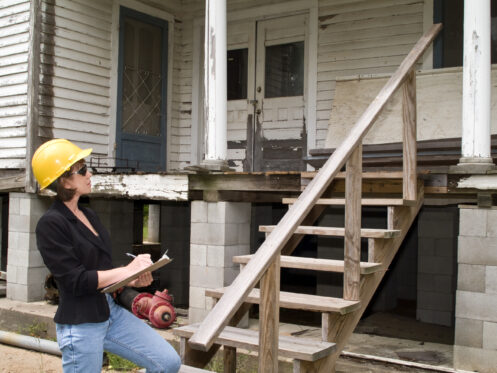As a homeowner, maintaining your property is key to ensuring its longevity and functionality. For older homes—those over 10 years old—regular checks are especially crucial. Aging structures can present unique challenges that, if left unaddressed, could lead to significant issues down the line. In this blog, we’ll explore the importance of regular inspections, common problems faced by older homes, how to conduct regular checks, and how to monitor your water meter.
Understanding the Aging Process
Homes, much like any other structure, undergo wear and tear over time. Various factors contribute to this aging process, including environmental conditions, the quality of materials used in construction, and maintenance history. As homes age, they become more susceptible to issues such as plumbing leaks, electrical malfunctions, and structural integrity problems. Regular inspections can help identify these problems early, allowing homeowners to take corrective actions before they escalate.
Common Issues in Older Homes
- Plumbing Problems: One of the most common issues in older homes is plumbing failure. Pipes made of copper or polyethylene often suffer from deterioration due to age and varying water quality, leading to leaks and inefficiencies. In contrast, homes that utilize PEX piping are generally less likely to experience these issues. PEX is known for its flexibility, resistance to scale and chlorine, and ability to expand without bursting, making it the recommended material for replacement in older plumbing systems. Regular checks of your water meter and plumbing can help identify leaks early, preventing costly repairs and excessive water bills.
- Electrical System Failures: Older electrical systems may not meet current safety standards or may be unable to handle modern electrical loads. This can lead to circuit overloads, tripped breakers, or even fire hazards. Regular electrical inspections can help ensure your system is safe and up to code.
- Roof and Gutter Issues: Over time, roofs can develop leaks due to missing shingles, wear, or storm damage. Clogged gutters can lead to water damage and structural issues. Regular inspections of the roof and gutter systems can prevent costly repairs and preserve the integrity of your home.
- Foundation Concerns: Foundation issues can arise due to soil erosion, poor drainage, or settling. Signs of foundation problems include cracks in walls, uneven floors, and doors that stick. Early detection through regular checks can prevent extensive damage and costly repairs.
- HVAC System Inefficiencies: Heating, ventilation, and air conditioning systems can lose efficiency over time. Regular maintenance checks can help ensure these systems operate effectively, providing comfort and saving on energy costs.
The Benefits of Regular Checks
- Cost Savings: By identifying and addressing issues early, homeowners can avoid costly repairs. For instance, fixing a small plumbing leak can prevent water damage that requires extensive repairs.
- Increased Safety: Regular inspections can identify safety hazards, such as faulty electrical wiring or structural issues, keeping you and your family safe.
- Peace of Mind: Knowing that your home is in good condition provides peace of mind. Regular checks allow you to enjoy your home without the constant worry of hidden issues.
- Preservation of Property Value: A well-maintained home retains its value better than one that is neglected. Regular checks and maintenance can help you avoid significant depreciation in your property value.
How to Conduct Regular Checks
Schedule Routine Inspections
Consider scheduling annual inspections for major systems such as plumbing, electrical, and HVAC. This can be done by professionals who specialize in home inspections.
Monitor Your Water Meter
Checking your water meter regularly is a straightforward way to catch potential leaks early. Here’s how to do it:
- Locate Your Water Meter: Find your water meter, typically located near the sidewalk or in a basement. Once located, carefully remove the cover.
- Check the Dial:
- If your meter has a dial, look for the small red dial.
- Observe it for one minute. If the dial moves even slightly, this indicates a leak, which could cost you over $150 a month!
- Check the Digital Meter:
- For digital meters, observe the fluctuating numbers. Typically, you want to see numbers under 2 or 3.
- Repeat Regularly: Make it a habit to check your water meter monthly to catch any changes early.
Inspect for Visual Cues
Take time to walk around your home and look for signs of wear and tear—cracks in walls, water stains on ceilings, or signs of pests.
Keep a Maintenance Log
Document repairs and inspections, including dates and any issues found. This can help you track patterns and plan for future maintenance.
Stay Informed
Be aware of the common issues associated with older homes and stay informed about best practices for maintenance and repairs.
Conclusion
Regular checks for older homes are not just a good idea—they’re essential. By being proactive about inspections and maintenance, homeowners can prevent significant issues, save money, and ensure their homes remain safe and comfortable for years to come. Whether it’s scheduling a professional inspection or simply checking your water meter, taking these steps can make a significant difference in the health and longevity of your home.
Don’t wait for a small problem to become a big one; start implementing regular checks today! If you have any questions or need assistance with inspections, don’t hesitate to reach out to our team—we’re here to help!





